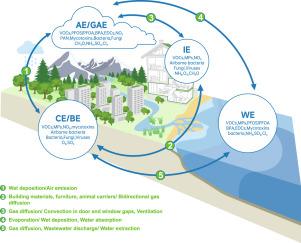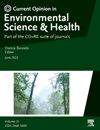The mini review of sustainable urban environment and emerging contaminants
IF 6.6
Q1 ENVIRONMENTAL SCIENCES
Current Opinion in Environmental Science and Health
Pub Date : 2025-07-28
DOI:10.1016/j.coesh.2025.100648
引用次数: 0
Abstract
This review examines emerging contaminants (ECs) and transitional one in five environments, focusing on air (ground-level and atmosphere), water, soil, and indoor. Key pollutants—volatile organic compounds, microplastics, Per and polyfluoroalkyl substances (PFAS), and bioaerosols—demonstrate cross-compartmental persistence, correlating with respiratory diseases, endocrine disruption, and immune risks. Indoor exposure dominates, driven by formaldehyde, microbial agents, and particulate matter. Advanced sensors and AI-enhanced monitoring enable real-time detection yet gaps persist in quantifying risks of novel ECs and scaling interventions. Prioritizing source control in built environments, alongside health-aligned and end point policies, is critical to mitigate exposure surrounded.

可持续城市环境与新兴污染物综述
本文综述了新兴污染物(ECs)和过渡性五分之一的环境,重点是空气(地面和大气)、水、土壤和室内。主要污染物——挥发性有机化合物、微塑料、Per和多氟烷基物质(PFAS)以及生物气溶胶——表现出跨室持久性,与呼吸系统疾病、内分泌干扰和免疫风险相关。室内暴露占主导地位,由甲醛、微生物剂和颗粒物驱动。先进的传感器和人工智能增强的监测能够实现实时检测,但在量化新型ECs风险和扩大干预措施方面仍然存在差距。在建筑环境中优先考虑源控制,以及与健康一致和终点政策,对于减轻周围的暴露至关重要。
本文章由计算机程序翻译,如有差异,请以英文原文为准。
求助全文
约1分钟内获得全文
求助全文
来源期刊

Current Opinion in Environmental Science and Health
Medicine-Public Health, Environmental and Occupational Health
CiteScore
14.90
自引率
0.00%
发文量
92
审稿时长
114 days
 求助内容:
求助内容: 应助结果提醒方式:
应助结果提醒方式:


